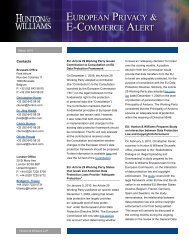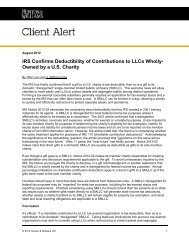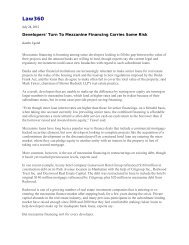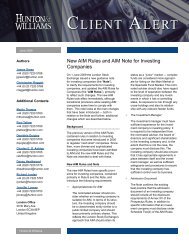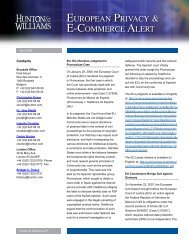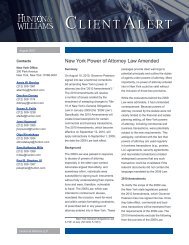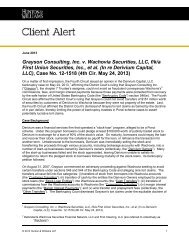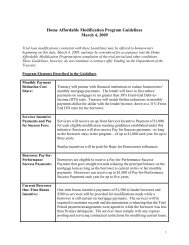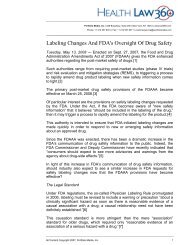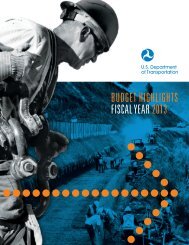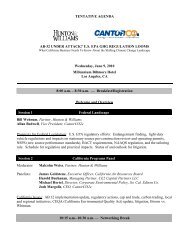Hunton & Williams Renewable Energy Quarterly, September 2009
Hunton & Williams Renewable Energy Quarterly, September 2009
Hunton & Williams Renewable Energy Quarterly, September 2009
Create successful ePaper yourself
Turn your PDF publications into a flip-book with our unique Google optimized e-Paper software.
<strong>Renewable</strong> <strong>Energy</strong> <strong>Quarterly</strong><br />
has been installed, tested and is ready and capable of its<br />
intended use and (c) an interconnection agreement for properties<br />
that are connected to a utility.<br />
Miscellaneous<br />
ÆÆ Applicants may request that the payment be assigned<br />
to a third party provided that certain requirements are<br />
met.<br />
ÆÆ The requirements of the National Environmental<br />
Policy Act (NEPA) and the Davis-Bacon Act do<br />
not apply to property for which a Treasury Grant is<br />
sought.<br />
ÆÆ Treasury Grant payments must be normalized under<br />
the rules of former Code Section 46(f).<br />
ÆÆ A Treasury Grant payment is not includible in the<br />
income of the applicant, but the basis of the property<br />
is reduced by 50 percent of the amount of the<br />
The requirements of the National<br />
Environmental Policy Act and the Davis-<br />
Bacon Act do not apply to property for<br />
which a Treasury Grant is sought.<br />
Treasury Grant (unless the property is the subject of a<br />
lessee pass-through election).<br />
ÆÆ The applicant is required to provide certain reports<br />
(including a project performance report) and<br />
certifications to Treasury and must maintain certain<br />
records as set forth in a terms and conditions<br />
document that the applicant must agree to and sign.<br />
Manufacturing Investment Tax Credit Program<br />
On August 13, <strong>2009</strong>, the Internal Revenue Service (the<br />
“Service”) issued Notice <strong>2009</strong>-72 (the “Notice”) establishing<br />
the qualifying advanced energy project program under<br />
Section 48C of the Internal Revenue Code (the “Code”). The<br />
American Recovery and Reinvestment Act of <strong>2009</strong> enacted<br />
a 30 percent investment tax credit for certain property used<br />
in a “qualified advanced energy project” — a project that<br />
re-equips, expands or establishes a manufacturing facility for<br />
the production of certain energy-related property.<br />
The tax credit is subject to a certification and allocation<br />
process. Thus, a taxpayer must be “awarded” an allocation<br />
of tax credits in order to claim the credit. The 73-page<br />
Notice describes in detail the application process, which is<br />
subject to tight deadlines — a preliminary application for the<br />
program was due by <strong>September</strong> 16, <strong>2009</strong>. The Secretary of<br />
the Treasury (the “Secretary”) is authorized to allocate up<br />
to $2.3 billion in such tax credits (which represents approximately<br />
$7.7 billion of investment in qualified advanced<br />
energy projects).<br />
This article is only a summary of certain aspects of the<br />
manufacturing investment tax credit program guidance.<br />
Complete details regarding the application process and the<br />
program guidance are available at http://www.energy.gov/<br />
recovery/48C.htm.<br />
Qualifying Advanced <strong>Energy</strong> Project and Eligible<br />
Property<br />
In order to qualify for the tax credit, the project must reequip,<br />
expand or establish a “manufacturing facility” for<br />
the production of “specified advanced energy property” or<br />
property that, after further manufacture, will become specified<br />
advanced energy property. A manufacturing facility<br />
is a facility that makes, or processes raw materials into,<br />
finished products (or accomplishes any intermediate stage<br />
in that process). Accordingly, the tax credit is for facilities<br />
that manufacture certain equipment (e.g., equipment that<br />
manufactures solar panels), and not for projects that use the<br />
equipment that is manufactured (e.g., a solar system that<br />
incorporates such solar panels). In addition, manufacturing<br />
facilities for the production of certain components of<br />
specified advance energy property are also qualified for the<br />
credit. For example, a project that manufactures wind turbine<br />
blades for a wind turbine is a qualifying project. Specified<br />
advanced energy property is:<br />
ÆÆ Property designed for the use in the production of<br />
energy from the sun, wind, geothermal deposits or<br />
other renewable resources;<br />
ÆÆ Fuel cells, microturbines or an energy storage system<br />
for use with electric or hybrid-electric motor vehicles;<br />
ÆÆ Electric grids to support the transmission of<br />
intermittent sources of renewable energy, including<br />
property for the storage of such energy;<br />
ÆÆ Property designed to capture and sequester carbon<br />
dioxide and to sequester carbon dioxide emissions;<br />
19 <strong>Renewable</strong> <strong>Energy</strong> <strong>Quarterly</strong> www.hunton.com



